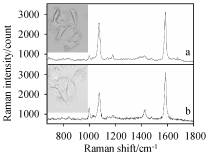化学学报 ›› 2011, Vol. 69 ›› Issue (16): 1890-1894. 上一篇 下一篇
研究论文
杨晶,王著元,张若虎,宋春元,李锦,高文成,崔一平*
YANG Jing, WANG Zhu-Yuan, ZHANG Ruo-Hu, SONG Chun-Yuan, LI Jin, GAO Wen-Cheng, CUI Yi-Ping

利用金纳米粒子的聚集体作为表面增强拉曼散射(Surface enhanced Raman scattering, SERS)的增强基底, 合成了一种二氧化硅包裹的核壳型SERS探针, 并成功将该探针应用于活细胞的SERS光谱探测. 实验中利用4-巯基苯甲酸(4-mercaptobenzoicacid, 4MBA)作为拉曼标记物, 并讨论了其在诱导金纳米粒子的聚集过程中的作用. 通过包二氧化硅外壳来实现对金纳米颗粒聚集程度的控制, 保持并优化了该探针的SERS活性. 同时, 通过在金纳米颗粒外包裹一层二氧化硅外壳, 该SERS探针的化学稳定性和生物兼容性得到了很大的提高. 利用紫外-可见吸收光谱仪以及透射电子显微镜研究了该探针中金纳米颗粒的聚集程度以及核壳结构的形貌. 实验结果表明该探针在活细胞内具有很好的SERS灵敏度, 并且生物兼容性好, 可以进一步用于细胞内生理活动监测.